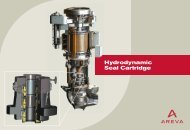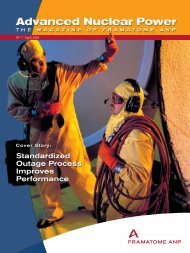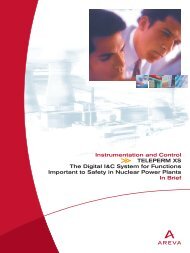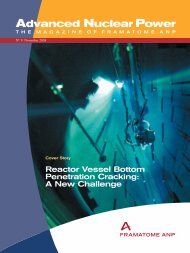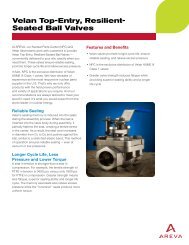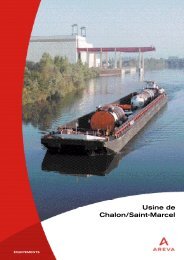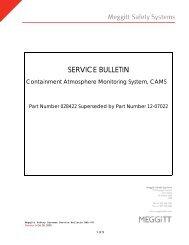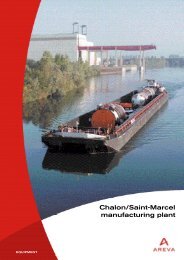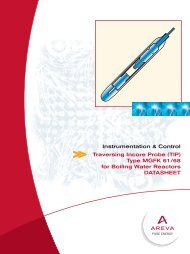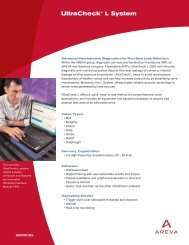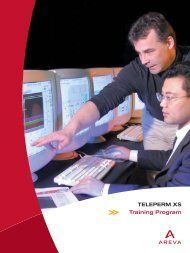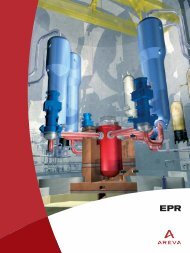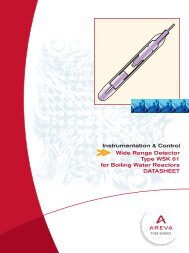Advanced Nuclear Power - AREVA
Advanced Nuclear Power - AREVA
Advanced Nuclear Power - AREVA
Create successful ePaper yourself
Turn your PDF publications into a flip-book with our unique Google optimized e-Paper software.
Projects & EngineeringProjects & EngineeringAngra 2: Energizing Brazil’s FutureBrazil's new PWR unit Angra 2, ratedfor an electric output of 1,309 MWe,started commercial operation inDecember 2000. Thus, eleven yearsafter startup of Germany's Neckar 2,Siemens (now Framatome ANP), inclose cooperation with its Brazilianpartner and customer, again successfullycompleted a new nuclear powerplant. Owner and operator of Angra 2is the state-owned companyELETRONUCLEAR - EletrobrásTermonuclear S.A. - based in Rio deJaneiro.Angra 2 incorporates the currentsafety standard of nuclear power plantsin Germany and therefore is one ofthe most modern units in the world.Above all, the plant will improve thepower supply situation in the economicregion of Rio de Janeiro/SãoPaulo with its more than 50 millioninhabitants who have suffered frequentpower shortages in recent months. Attoday's annual per capita consumptionin Brazil of 2,100 kilowatt-hours,Angra 2 is capable of supplying electricityto about five million people.Brazilian Companies ProvideOver 50% of All Supplies andServicesAngra 2 is the first nuclear powerplant to be completed under the termsof the 1975 German-Brazilian intergovernmentalagreement on cooperationin the field of peaceful uses ofnuclear energy. The plant was built toSiemens' design in close cooperationbetween Siemens and ELETRONU-CLEAR, as well as other German andBrazilian companies.The contract covering suppliesand engineering services for Angra 2and 3 was signed in 1976 between theBrazilian electric utility Furnas andSite for Angra3Siemens. Two of the main requirementsstipulated in the contract werethat there should be an extensivetransfer of technology and thatBrazilian companies should beinvolved to the greatest extent possible.This led in 1977 to the foundingof the Brazilian engineering company,NUCLEN, in which Siemens held a25% share. Also, technology transferand cooperation agreements were concludedby numerous companies inBrazil and Germany. The manufacturingcompany, NUCLEP, was set up atItaguaí, 80 km south-west of Rio deJaneiro for fabricating reactor componentsfor future nuclear powerplants in Brazil.The agreed scope of technologytransfer included not only the handingover of a large number of technicaldocuments and the granting of licensesand patents, but also an extensivetraining program for Brazilian engineersin Germany. A total of over 250junior engineers from NUCLENalone have been trained at Siemensunder this program. As a result,NUCLEN was able to perform a largeproportion of the engineering work aswell as supervision of construction anderection, with support being provided,when necessary, by experiencedSiemens specialists and managers integratedinto the project team. As aresult of this comprehensive technologytransfer Brazilian companiesprovided over 50% of all suppliesand services.Progress Delayed in the 1980sby Brazil's Economic ProblemsConstruction of Angra 2 began in1977. After pile foundation work hadbeen completed in the Bay of Angrados Reis, erection of the civil structureswas started in 1981. All heavyengineering equipment for Angra 2and 3, such as the components of thenuclear steam supply system and theturbine generator set were shipped toBrazil in the early 1980s. In the mid-80s, a slowdown in the developmentof Brazil's economy resulted in a slowergrowth in electricity consumptionthan had been anticipated. As a consequence,work was halted at Angra 3and was reduced to a minimum atAngra 2. Nevertheless, it was still possibleto complete a large proportion ofthe heavy construction work, to startfinishing work inside the buildingsand, in the fall of 1994, to rig thereactor pressure vessel, steam generatorsand reactor coolant pumps intothe containment.Work Takes Off Againin the 1990sThis situation changed decisively in1995. The Brazilian governmentassigned high priority to the Angra 2project to reduce the power supplydeficit in the now rapidly growing economicregion of Rio de Janeiro/SãoPaulo, and provided the necessaryfunding. The first mechanical andelectrical components were installed inthe same year. The main erectionactivities (piping and other componentsas well as electrical equipmentand instrumentation and control(I&C) systems) were started in thesummer of 1996 by the Brazilian consortium,UNAMON. The work wascoordinated and monitored by thecustomer's site management, withsupport provided by personnel fromSiemens and its subcontractors.With up to 6000 peopleemployed on the site at any one time,work now progressed rapidly. Turbinegenerator set erection began inOctober 1996 and initial system startupsin the second half of 1997. Thecontainment pressure test was performedin late 1997 to early 1998 and,finally, pre-core hot functional testingalong with emergency coolant injectiontests were performed inSeptember 1999. As soon as the initialcore had been loaded into the reactorin March 2000, ELETRONUCLEARtook over responsibility for plant operationsmanagement. Following successfulcompletion of the post-core hotfunctional tests, the reactor went criticalfor the first time on July 14, 2000and power started to be fed into theoffsite power system on July 21, 2000.During the power ascension phasethat followed, tests were performed tosimulate all postulated design basisaccidents. The results demonstratedthe plant's excellent performanceunder such conditions. In November2000, the 28-day trial run was startedand was successfully concluded onDecember 21, 2000.Looking Ahead to Angra 3Starting in November 1998, approximately30 junior Siemens employeesfrom various engineering departmentsresponsible for systems design, componentcalculations, heating, ventilationand air-conditioning, piping, electricaland I&C systems, among others, wereintegrated into the startup activities.During their approximately six-monthstay in Angra, these young engineersacquired experience in nuclear systemstartup, pre-core and post-core hotfunctional testing and power ascensiontesting. The objective was to expandtheir skills beyond those needed fordesign and procurement to cover thefull spectrum of engineering activitiesrequired for the overall plant with allof its various systems and components- thus making a vital contributiontowards safeguarding expertise in thefield of nuclear power generation forthe future.This expertise probably will beneeded soon for Angra 3 since thecontinuing rapid growth in electricitydemand, the successful completion ofAngra 2 and the large investmentalready made for Angra 3 are likely tolead to the completion of Angra 3.Construction and installation workwill be carried out by experiencedBrazilian contractors in close cooperationwith Framatome ANP. @Angra 1 on the left, Angra 2 on the right4 <strong>Advanced</strong> <strong>Nuclear</strong> <strong>Power</strong> 08/200108/2001 <strong>Advanced</strong> <strong>Nuclear</strong> <strong>Power</strong> 5



